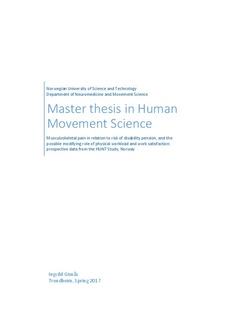| dc.description.abstract | Musculoskeletal pain is a significant cause of years lived with disability, and expenses of examination and treatment, reduced work ability, sickness absence and disability benefits are considerable. A better understanding of work-related factors that can modify the association between pain and disability is essential, in order to develop effective preventive strategies. The aim of the current study was to examine the independent effects of musculoskeletal pain, physical workload and work satisfaction on risk for disability pension, as well as the possible modifying role of physical workload and work satisfaction on the relation between musculoskeletal pain and disability pension risk. Data on 44 713 individuals, originating from the second wave of the Nord-Trøndelag Health Study (HUNT2, 1995-97), was linked to a national registry on incident disability pension from Statistics Norway (FD-trygd, follow-up through 2007). We used Cox regression analyses to estimate adjusted relative risks (RRs) of disability pension associated with musculoskeletal pain and work-related factors. Precision of the estimated associations was assessed by 95% confidence intervals (95% CIs). Additionally, tests of statistical interaction (i.e., deviation from multiplicativity or additivity) were conducted, to explore possible synergistic effects. During the 10-year follow-up, 6764 individuals (15.1 %) became recipients of disability pension. Chronic musculoskeletal pain was strongly associated with risk of disability pension (males: RR 2.06, 95% CI 1.90-2.24; females: RR 2.59, 95% CI 2.40-2.79), and activity-interfering pain increased the risk even further. The independent effects of physical workload and work satisfaction were modest; however, individuals who concurrently experienced chronic pain and had heavy physical work or low work satisfaction were at the highest risk of disability pension. For males and females with pain and heavy physical work, RRs and 95% CIs were 2.60 (2.24-3.02) and 3.37 (2.88-3.95), respectively. For the joint effects of pain and low work satisfaction, RRs and 95% CIs were 2.98 (2.34-3.79) for males and 3.29 (2.67-4.07) for females. Despite the strong associations, there were no statistically significant interaction between these factors, based on p-values from the multiplicative test and RERI estimates with 95% CIs from the additive test. In conclusion, musculoskeletal pain is positively associated with disability pension risk, and work-related factors such as physical workload and work satisfaction may contribute to a further amplification of this risk. Persons with musculoskeletal pain exposed to heavy physical work, or with low work satisfaction, should be given special attention to prevent early work disability. | nb_NO |
